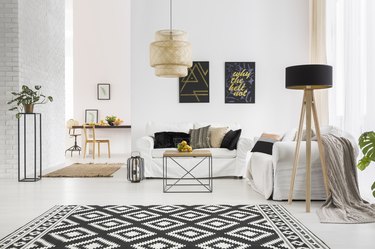An echo is caused by sound waves bouncing off a hard surface so that you hear the same sound again. Large rooms in homes can create echoes, especially if the room has mostly hard, bare surfaces, high ceilings or does not have much furniture. Echoes can be annoying, especially in a room where you sit and talk or watch TV. You can soften a room from echo by decorating the room in a way that absorbs sound.

Video of the Day
Sound and Echo
Echo is most pronounced when soundwaves hit a flat, hard, smooth surface such as a glass wall, or concrete floor because sound waves remain intact when they hit a smooth surface. Lining surfaces with a textured soft material like foam or cloth helps break up the waves and absorb sound. This is why sound studios typically have carpeted floors and walls and ceilings lined with rippled or rigid foam.
Video of the Day
Rugs and Carpet
Hard floors are often the culprits in producing an echo in a room. Laminate flooring can be particularly noisy, echoing and magnifying footsteps, especially if you are wearing hard-soled shoes. Muffle the sound by installing wall-to-wall carpet or by covering at least half of the floor with a large, thick area rug. This will absorb sound waves and prevent them from bouncing off the floor. Choose carpet or rugs that have long fibers for the most sound absorption.
Curtains or Drapes
Long stretches of wall provide a lot of surface for bouncing sound waves and contribute to an echo in a room. Soften the echo by hanging heavy drapes over windows that will serve to break up the expanse of bare wall and provide a soft surface that absorbs sound. Heavy, lined curtains will work best. If you are trying to reduce echo in a room that is used for TV watching or video game play, look for blackout curtains, which are lined to block out the light.
Furniture
The more furniture that is in the room, the less area there is to bounce sound waves. This does not mean you have to clutter up your room, but rather choose furniture that is upholstered with soft fabrics instead of leather, and use throw blankets and toss cushions to further soften the room. Hang paintings or canvas artwork on the walls to add to your style as well as provide a surface to absorb instead of reflecting sound.
Acoustic Panels
If all else fails, or you have an echo in a room that requires good sound quality, such as a home theater or home-recording studio, consider installing acoustic foam panels. Acoustic panels are made of sound absorbent material like foam or cloth and are designed in such a way as to create a rough, textured surface to further break up sound waves. These panels are easily installed with pins, small nails or adhesives, and come in a wide range of decorator colors. You can even order acoustic panels with photos or artwork designs. Panels should be installed every 12 inches for good sound absorption.
Installing panels in a home theater or TV room is a great way to keep sound contained and to be able to listen to what you're watching without having to turn the volume way up. There is a pattern that sound waves follow, and in order to best place your acoustic panels, you'll need to make sure you place acoustic panels or other sound absorption materials at all the "specular reflection points." These are the places where the sound bounces.